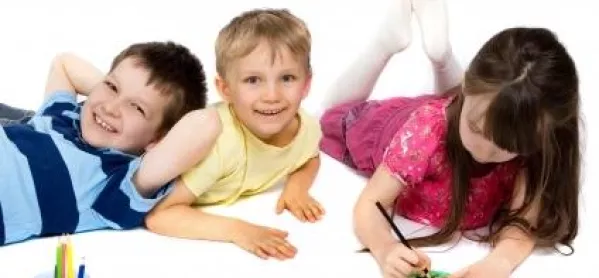Early years boys are far more likely to be physically affectionate with one another - touching one another’s faces and blowing kisses - than girls of the same age, according to new research.
Andolie Marguerite of London’s Goldsmiths College found that five-year-old boys used playful hugging, kissing and fighting in the same way that their older counterparts might play-fight to reinforce locker-room maleness.
Miss Marguerite studied four reception classes in two schools, observing pupils’ physical interaction with one another and with their teachers.
She found that boys were far more likely than girls to make physical contact with one another. They also had a broader repertoire of touch incorporating hugging, kissing, pushing and poking.
“Boys were much more physically affectionate with each other, often touching others’ heads or faces,” she said.
“Several pairs of boys would put their faces close to each other and blow kisses. The carpeted area in class was used by some boys for touching games and play-fighting.”
This behaviour was repeated frequently and was not remarked on by other children.
Girls, meanwhile, were more likely to look and smile at one another than boys. The only physical affection that girls showed was the occasional semi-parental hug.
Miss Marguerite noticed similar behaviour when pupils lined up to move from one part of the school to another. “While waiting, children would touch each other, often affectionately,” she said. “But this sometimes became poking or slapping. Pairs of boys would often gently touch each other.”
Girls, by contrast, would lean against one another rather than actively touching.
Body language was also used by pupils to mark them out as either definitively male or female. So when Calvin, a tall, muscular, shaven- headed boy, was on his own, he happily donned a pair of butterfly wings and danced delicately for Miss Marguerite. But as soon as other pupils joined in, he began to incorporate kicks and displays of strength into his dance.
Physical contact between pupils and adults was strictly regulated by the school, and pupils were not expected to touch teachers. However, both boys and girls used touch to establish relationships with adults.
So when the trainee headteacher was reading to pupils, many girls crept up to her and touched her tights. “I thought perhaps her tights were particularly smooth or sparkly,” said Miss Marguerite. “But I feel now that it is part of a culture of physicality where touch signifies or establishes a relationship.”
Similarly, two boys approached Miss Marguerite and touched her shoes. Again, she concluded that this was an attempt to establish a relationship through touch.
“The use of the body through the processes of touch and body positioning felt strongly as if they were part of a process of creating sameness and difference between the children,” she said.
“I was struck by the power of touch and body position to evoke a sense of identity.”
FEEL-GOOD FACTOR
- Boys showed a wider range of physical interactions than girls, from poking and pushing to hugging and kissing.
- Boys were often tactile with one another’s heads or faces or blew kisses.
- Girls tended to be more parental than boys - for example, putting their arms around their friends.
- Behaviour was often dictated by the presence of peers of the same sex: boys would be less likely to act in a delicate, “girly” manner with other boys present.
- In queues, boys would move their friends so that they were aligned with the pupils in front of them.
- Pupils of both sexes tended to touch the feet, shoes or ankles of adults as a way of establishing a relationship.




